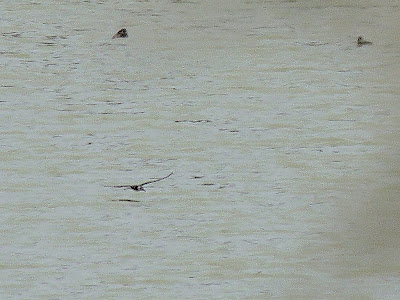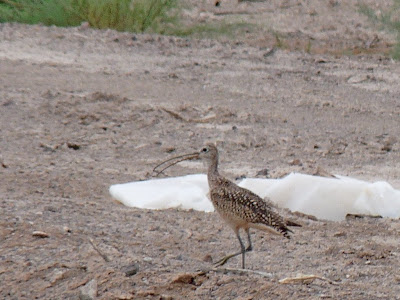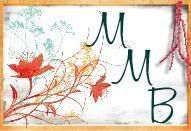Hey! If you want something fun to do with your kids, or need a chance to get outside, the Great Backyard Bird Count is this coming weekend! It's a great opportunity to do some citizen science, and have a good time.
For more information you can check out their web site at http://www.birdsource.org/gbbc/
It is really quite simple, you just find a place where you can watch birds for at least 15 minutes (ie. your yard, a park, a wildlife preserve, and count the highest number of each species that you see at one time. Keep track of your findings and then enter them before March 1 on the web site. Scientists have been using the results of these surveys for years to help them keep track of changes in various bird populations. The bird count goes from Feb. 12 to Feb. 15 and it's a fun activity for anyone.
Monday, February 8, 2010
Friday, January 1, 2010
The Grand Total
HBVP Birds I Saw in 2009
January 3 (38 species)Snow Goose
Wood Duck
Gadwall
Mallard
Blue-winged Teal
Cinnamon Teal
Northern Shoveler
Northern Pintail
Green-winged Teal
Ring-necked Duck
Lesser Scaup
Bufflehead
Common Merganser
Ruddy Duck
Gambel's Quail
Pied-billed Grebe
Eared Grebe
Great Egret
Black-crowned Night Heron
Northern Harrier
Red-tailed Hawk
Common Moorhen
American Coot
Greater Yellowlegs
Least Sandpiper
Ring-billed Gull
Mourning Dove
Greater Roadrunner
Costa's Hummingbird
Black Phoebe
Verdin
Black-tailed Gnatcatcher
Yellow-rumped Warbler
Orange-crowned Warbler
Abert's Towhee
White-crowned Sparrow
Great-tailedGrackle
House Finch
January 10 (46 species)
Bewick's Wren
Say's Phoebe
American Pippit
Ruby-crowned Kinglet
Green Heron
Sharp-shinned Hawk
Ross's Goose
Dunlin
January 17 (49 species)
Canada Goose
Prairie Falcon
Northern Flicker
January 24 (55 species)
Redhead
Snowy Egret
Peregrine Falcon
Anna's Hummingbird
Loggerhead Shrike
Song Sparrow
January 31 (58 species)
Common Goldeneye
Marsh Wren
Crissal Thrasher
February 7 (63 species)
Double-crested Cormorant
Killdeer
Tree Swallows
Western Sandpiper
Cassin's Kingbird
February 14 (66 species)
American Wigeon
Virginia Rail
Sora
February 21 (67 species)
Red-winged Blackbird
February 28 (73 species)
American Avocet
Semipalmated Sandpiper
Long-billed Dowitcher
Common Raven
Violet-green Swallow
Northern Rough-winged Swallow
March 14 (76 species)
Barn Swallow
Savannah Sparrow
Yellow-headed Blackbird
April 6 (80 species)
Long-tailed Duck
Golden Eagle
Turkey Vulture
Black-chinned Hummingbird
April 11 (84 species)
Bonaparte's Gull
Black-necked Stilt
Marbled Godwit
Cliff Swallow
April 18 (85 species)
Brown-headed Cowbird
April 25 (90 species)
Spotted Sandpiper
Wilson's Phalarope
Nashville Warbler
Wilson's Warbler
House Sparrow
May 2 (92 species)
European Starling
Bullock's Oriole
May 9 (97 species)
Rock Dove
Northern Mockingbird
Western Wood Peewee
Common Yellowthroat
Yellow Warbler
May 22 (102 species)
Western Grebe
Western Kingbird
Hooded Oriole
Blue Grosbeak
Yellow-headed Chat
May 29 (106 species)
Least Bittern
White-faced Ibis
Eurasian Wigeon
Brewer's Sparrow
July 11 (107 species)
Indigo Bunting
July 17, (108 species)
Common Nighthawk
July 18 (111 species)
American Kestrel
Great Blue Heron
Cattle Egret
July 24 (112 species)
Eurasian Collared Dove
July 25 (114 species)
Long-billed Curlew
Great Horned Owl
August 1 (115 species)
Osprey
August 8 (116 species)
Solitary Sandpiper
August 22 (120 species)
Black Tern
Rufous Hummingbird
Black-headed Grosbeak
Lazuli Bunting
September (121 species)
Gray Flycatcher
October 31 (123 species)
Canvasback
Cooper's Hawk
November 7 (125 species)
American White Pelican
Summer Tanager
December 12 (127 species)
Vermilion Flycatcher
Bushtit
Saturday, August 22, 2009
August 22
I saw 4 new birds today and I'm up to 120! Pretty good, eh? I thought so, I still have 4 months of birding and fall migration to go. But, my friend Lupe has 130! Dang, more birding is in order!
 This was the easiest bird of the day; Lupe pointed out this Lazuli Bunting right behind the visitor's center. Later I saw a Black-Headed Grosbeak off the patio, and a Rufous Hummingbird at the feeder.
This was the easiest bird of the day; Lupe pointed out this Lazuli Bunting right behind the visitor's center. Later I saw a Black-Headed Grosbeak off the patio, and a Rufous Hummingbird at the feeder.

This Black Tern was on Pond 8. Pond 8 was a great pond today. It was quite low with mudflats and rocky islands, and was packed with shorebirds. I saw dowitchers, Wilson's Phalaropes, Least and Western Sandpipers, American Avocets and Black-necked Stilts, several Northern Shovelers, and a Willet was seen there, too. I also saw a Bullock's Oriole on Pond 1, and got a great look at a Black-tailed Gnatcatcher. On Pond 9 I saw a Least Bittern, Snowy Egrets, and Black-Crowned Night-Herons. It was the most productive day birding I've had in a while.
 This was the easiest bird of the day; Lupe pointed out this Lazuli Bunting right behind the visitor's center. Later I saw a Black-Headed Grosbeak off the patio, and a Rufous Hummingbird at the feeder.
This was the easiest bird of the day; Lupe pointed out this Lazuli Bunting right behind the visitor's center. Later I saw a Black-Headed Grosbeak off the patio, and a Rufous Hummingbird at the feeder.
This Black Tern was on Pond 8. Pond 8 was a great pond today. It was quite low with mudflats and rocky islands, and was packed with shorebirds. I saw dowitchers, Wilson's Phalaropes, Least and Western Sandpipers, American Avocets and Black-necked Stilts, several Northern Shovelers, and a Willet was seen there, too. I also saw a Bullock's Oriole on Pond 1, and got a great look at a Black-tailed Gnatcatcher. On Pond 9 I saw a Least Bittern, Snowy Egrets, and Black-Crowned Night-Herons. It was the most productive day birding I've had in a while.
Saturday, August 8, 2009
August 8
I saw a solitary Solitary Sandpiper today. (A little bird humor for you!) I also figured out that I have somehow managed to fill up an 8 MG card with pictures of birds and my kids! So no pictures today. But it was really nice at the Bird Preserve; it was surprisingly cool in the morning and there were mudflats on Pond 1. That's were I saw the little loner, and a lot of other birds, including Wilson's Phalaropes, Green Herons, a Great Blue Heron, Great and Snowy Egrets, Western and Least Sandpipers, Killdeer and a handful of others.
Sunday, August 2, 2009
August 1, catching up again
Here's a bird for you ladies! These are Wilson's Phalaropes feeding. They spin like tops to create a vortex that stirs up their food. Not only are they fun to watch, they are very unusual because they have reversed sex roles. The females are larger and more brightly colored than the males and do the courting, and the males incubate the eggs and care for the chicks. Kind of an interesting bird. I saw these on August 1.
Sorry I have a bad case of brain fry. It's not heat stroke or heat exhaustion, it's just a general feeling of blah and a lack of energy and enthusiasm. I've been going to blog for weeks, but I haven't. But I do have several "new" birds to add to my list, so I'll get cracking.

On July 17, I saw this Common Nighthawk. It caught me by surprise; I usually see them very early in the morning, but I saw this one late in the afternoon as I was leaving. He was pretty cooperative and let me get a good look.
Then on July 18, I saw three birds that I was a little surprised that I hadn't seen earlier in the year: a Kestrel, Great Blue Heron, and a Cattle Egret.
On July 24, I saw a Eurasian Collared Dove, just outside the visitor's center. I tried to take a picture, but it did not cooperate and flew away when I opened the back door. Rude!
On July 25, I had a Great Horned Owl. I was was walking with a group and I was so surprised to see it fly out of a group of trees near the intersection between pond 4, 7 and 5 and over into the tamarisk on Pond 4, that I just stuttered for a minute before I got out "Owl!"

Also on July 25, I got great looks at this Long-billed Curlew. He was in Pond 8, but my approach startled him and he flew over the fence into the area behind the Bird Preserve. But he must have felt safe behind the fence, because he let me take several pictures of him.
Finally, on August 1, my friend Lupe and I observed an Osprey flying over the ponds.
Summer is always quieter at the Bird Preserve, but I am always amazed at the variety that can be found even when it is an oven outside. The staff is still recording about 60 to 70 different species every week, and I usually see 20-30 in a hour's birding. Here are few other birds that I have seen lately.
Sunday, July 12, 2009
July 11, and a catch-up post
 I'm back from my blog-cation, with 4 new life birds from my real vacation, and 1 "new" bird from the Henderson Bird Viewing Preserve.
I'm back from my blog-cation, with 4 new life birds from my real vacation, and 1 "new" bird from the Henderson Bird Viewing Preserve.We went to Idaho and Utah to visit our families, and while we were in Idaho we went to Yellowstone National Park. My parents took us to LaHardie Rapids and we saw a MALE HARLEQUIN DUCK! (Oh, sorry, I'll calm down now.) I was really excited, it was a beautiful bird and as you can see was hanging out in some crazy water. I also added Clark's Nutcracker and a Gray Jay to my life list in Yellowstone, I'm sure I've seen them before camping in Yellowstone with my family, but I wasn't birding back then.
I also saw my first Gray Catbird in Idaho. I was poking around along the canal bank that runs down the back of my parents back yard when I thought I heard a cat mewing. I went to investigate and found not a cat, but a catbird! Pretty good when you get a life bird in your parents back yard!
Now for the bird that really counts on this blog: I saw an Indigo Bunting at the Bird Preserve! What a great bird! It's not on the checklist at the BVP, so it was pretty exciting to see. It was especially fun because the last few times I've been to the Bird Preserve, I haven't seen any "new" species and things get pretty quiet during the summer. However, there are still lots of babies at the Bird Preserve and they are always fun to watch.
 An eared grebe carrying its baby on its back.
An eared grebe carrying its baby on its back.Tuesday, June 2, 2009
May 29
A life bird, four "new" species for the year, and some other cool stuff! Not a bad day of birding!
The first "new" bird I saw was the Least Bittern which I spooked out of some vegetation on the bank of Pond 9 first thing in the morning. He flew into the next clump of rushes and before I had the chance to get the camera on him he had disappeared.
Later that day I saw my lifebird, a Eurasian Wigeon, also on Pond 9. A new life bird is pretty exciting, that makes two for this year.
There was also a flock of Brewer's Sparrows flitting from bush to bush along the edge of Pond 9. And I finally found a White-faced Ibis! I can't believe it took this long!
 I also saw this male (note the blue on his throat) Desert Spiny Lizard near Pond 7. He was doing "push-ups" on the rock. I later read on the Internet that it is a territorial display.
I also saw this male (note the blue on his throat) Desert Spiny Lizard near Pond 7. He was doing "push-ups" on the rock. I later read on the Internet that it is a territorial display.
Then a couple of Killdeer and a Roadrunner put on a real show for me. I arrived just in time to see two Killdeer run off a Roadrunner from their nest. Then one of the parents pretended to have a broken wing to lead me away from their nest. I backed off, but before I left I saw the killdeer that was sitting on the nest do an interesting thing that I had just read about that morning in a birding magazine. She went over to the edge of the pond, wet her belly feathers and came back and crouched over her eggs. Apparently as the water evaporates it cools the eggs. I read that Killdeer eggs are only viable to 108 degrees. This nest was out in the open and the only protection from the southern Nevada heat was what the parents could provide with their bodies. Amazing that they can pull it off.
And finally, I saw a Turkey Vulture running around on the ground. I think he had been feeding on a dead coot that was nearby. Not something you see every day.
The first "new" bird I saw was the Least Bittern which I spooked out of some vegetation on the bank of Pond 9 first thing in the morning. He flew into the next clump of rushes and before I had the chance to get the camera on him he had disappeared.
Later that day I saw my lifebird, a Eurasian Wigeon, also on Pond 9. A new life bird is pretty exciting, that makes two for this year.
There was also a flock of Brewer's Sparrows flitting from bush to bush along the edge of Pond 9. And I finally found a White-faced Ibis! I can't believe it took this long!
 I also saw this male (note the blue on his throat) Desert Spiny Lizard near Pond 7. He was doing "push-ups" on the rock. I later read on the Internet that it is a territorial display.
I also saw this male (note the blue on his throat) Desert Spiny Lizard near Pond 7. He was doing "push-ups" on the rock. I later read on the Internet that it is a territorial display.Then a couple of Killdeer and a Roadrunner put on a real show for me. I arrived just in time to see two Killdeer run off a Roadrunner from their nest. Then one of the parents pretended to have a broken wing to lead me away from their nest. I backed off, but before I left I saw the killdeer that was sitting on the nest do an interesting thing that I had just read about that morning in a birding magazine. She went over to the edge of the pond, wet her belly feathers and came back and crouched over her eggs. Apparently as the water evaporates it cools the eggs. I read that Killdeer eggs are only viable to 108 degrees. This nest was out in the open and the only protection from the southern Nevada heat was what the parents could provide with their bodies. Amazing that they can pull it off.
And finally, I saw a Turkey Vulture running around on the ground. I think he had been feeding on a dead coot that was nearby. Not something you see every day.
Subscribe to:
Posts (Atom)









